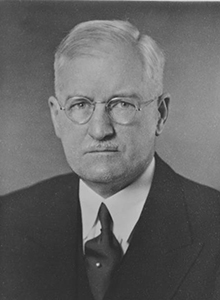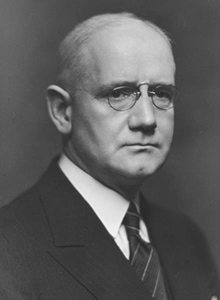
Ira Clerk
- President, Federal Reserve Bank of San Francisco, 1946 – 1946
- Born: June 21, 1885
- Died: September 28, 1946
Ira Clerk served as the president of the Federal Reserve Bank of San Francisco from January 1, 1946, until his death eight months later at age of sixty-one.
Clerk was born in 1885, in Ingham, a town in Queensland, Australia. He attended the Boys Normal School in Brisbane for three years and spent a year at the Toowoomba Grammar School. His formal education ended at age sixteen.
Clerk started his financial career in 1902 at the New Zealand Loan and Mercantile Agency Company in Brisbane. Three years later, he moved to the United States and worked at the Sanger Lumber Company of California for a short time.
From 1906 to 1912, Clerk took on various roles at The Canadian Bank of Commerce's branches in San Francisco, Portland, and British Columbia. In 1913 he returned to San Francisco to work at the Bank of Italy. He became a naturalized U.S. citizen in 1914.
Clerk started at the San Francisco Fed on November 2, 1914, as a part of a group of men borrowed from local banks to prepare for its opening. He stayed on as an auditor and moved up to assistant cashier in 1917, cashier in 1918, and assistant deputy governor in 1919. In 1920 he organized the Los Angeles branch as acting manager, but returned to the head office in San Francisco later that year.
In a 1924 internal newsletter, Clerk, then assistant deputy governor, wrote an essay encouraging Federal Reserve employees to take their professional development seriously so they would be effective in dealing with "the emergency which may arrive tomorrow."
"If human nature did not assert itself," Clerk wrote, "there would not be periodical recurrences of different phases of business ranging from the heights of prosperity to the depths of depression. There never has been, and probably never will be, a cure for these changing conditions. The Federal Reserve System is not a cure; it is merely an antidote which serves to hold evil effects in check while trade and commerce adjust themselves under the guiding hand of the business men of the Nation."1
In 1925 Clerk was made deputy governor, a title that changed to vice president after passage of the 1935 Banking Act. Clerk was appointed first vice president in 1936. That year, he co-authored the "Report of the Federal Reserve Committee on Acceptance Practice," which found that most financial losses by American banks on bankers' acceptances were due to poor judgment rather than lax or restrictive regulations: "It must be recognized that in the long run sound acceptance practice depends most largely on sound credit judgment on the part of the accepting bank, and the principal reliance for improvement in practice must be placed upon the gradual process of the seasoning of judgment of acceptors and the development of sound traditions."2
Clerk became president of the San Francisco Fed on New Year's Day 1946. Unfortunately, his time at the top was short lived.
"His death at the age of sixty-one on September 28, 1946, so soon after his appointment to the highest executive office in his Bank came as a great shock to his family, friends, and associates," it was written in an employee newsletter dated October 1946. "His was the unique distinction of having been the only person in any Federal Reserve bank who had been an officer continuously since the Federal Reserve banks opened."3
In closing his 1924 essay, Clerk wrote, "The man who finds Federal Reserve banking dull is blind to the opportunities and possibilities which lie before him."4
Written by the Federal Reserve Bank of San Francisco. See disclaimer and update policy.




 X
X  facebook
facebook
 email
email